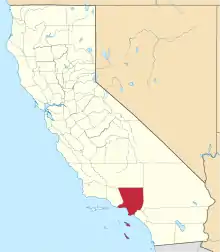Culver City, California
Culver City is a city in Los Angeles County, California. As of 2019, the estimated population was 39,185. The city was named after its founder, Harry Culver.[9] Originally founded as a whites-only city, or sundown town, since the 1980s it has become fairly diverse with one of the most diverse school systems in the United States.[10][11] It is mostly surrounded by the city of Los Angeles, but also shares a border with unincorporated areas of Los Angeles County. Over the years, it has annexed more than 40 pieces of adjoining land and now comprises about five square miles (13 km2).
Culver City, California | |
|---|---|
City | |
| City of Culver City | |
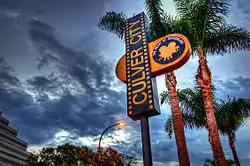 Culver City sign at sunset in October 2010 | |
 Flag 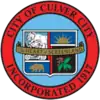 Seal | |
| Motto(s): "The Heart of Screenland" | |
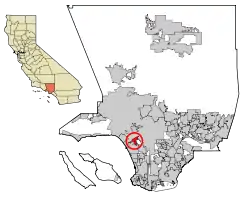 Location within Los Angeles County | |
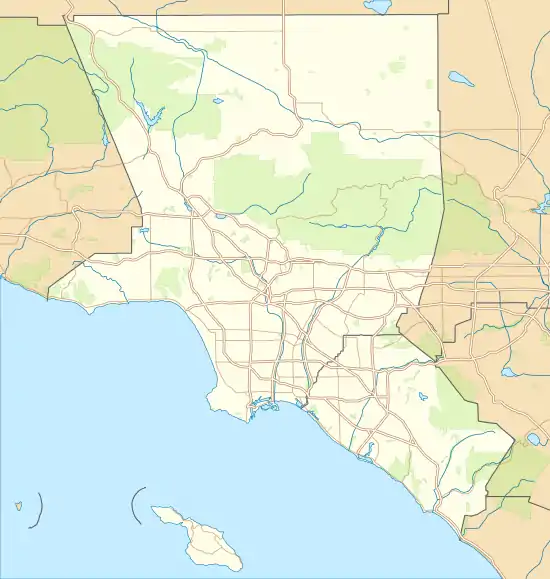 Culver City Location within the Los Angeles metropolitan area 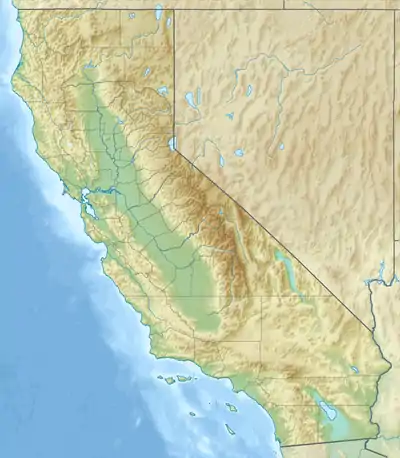 Culver City Location within California  Culver City Location within the United States | |
| Coordinates: 34°0′28″N 118°24′3″W | |
| Country | |
| State | |
| County | |
| Incorporated | September 20, 1917[1] |
| Named for | Harry Culver |
| Government | |
| • Type | Council-manager |
| • Mayor | Alex Fisch |
| • Vice Mayor | Daniel Lee |
| • City Council | Göran Eriksson Yasmine-Imani McMorrin Albert Vera |
| • City Manager | John M. Nachbar[2] |
| Area | |
| • Total | 5.14 sq mi (13.31 km2) |
| • Land | 5.11 sq mi (13.24 km2) |
| • Water | 0.03 sq mi (0.07 km2) 0.54% |
| Elevation | 95 ft (29 m) |
| Population | |
| • Total | 38,883 |
| • Estimate (2019)[6] | 39,185 |
| • Density | 7,666.80/sq mi (2,960.25/km2) |
| Time zone | UTC−8 (Pacific Time Zone) |
| • Summer (DST) | UTC−7 (PDT) |
| ZIP Codes | 90230–90233, 90066[7] |
| Area codes | 310/424[8] |
| FIPS code | 06-17568 |
| GNIS feature IDs | 1652695, 2410276 |
| Website | www |
Since the 1920s, Culver City has been a center for motion picture and later television production, best known as the home of Metro-Goldwyn-Mayer studios. From 1932 to 1986, it was the headquarters for the Hughes Aircraft Company. National Public Radio West and Sony Pictures Entertainment have headquarters in the city. The NFL Network studio is also located in Culver City.
History
| Historical population | |||
|---|---|---|---|
| Census | Pop. | %± | |
| 1920 | 503 | — | |
| 1930 | 5,669 | 1,027.0% | |
| 1940 | 8,976 | 58.3% | |
| 1950 | 19,720 | 119.7% | |
| 1960 | 32,163 | 63.1% | |
| 1970 | 34,451 | 7.1% | |
| 1980 | 38,139 | 10.7% | |
| 1990 | 38,793 | 1.7% | |
| 2000 | 38,816 | 0.1% | |
| 2010 | 38,883 | 0.2% | |
| 2019 (est.) | 39,185 | [6] | 0.8% |
| U.S. Decennial Census[12] | |||
Early history
Archaeological evidence suggests a human presence in the area of present-day Culver City since at least 8000 BC.[13] The region was the homeland of the Tongva-Gabrieliño Native Americans. For centuries, native people lived in areas currently part of and surrounding Culver City.[14][15][16] California's native people were massacred by waves of Spanish, Mexican and Euro-American invaders through a combination of slavery, disease, relocation, forced labor, imprisonment, broken treaties and a genocidal war of extermination, including paid bounties for dead “Indians”.[17] The Spanish and Mexican governments offered concessions and land grants from 1785 to 1846 forming the Ranchos of California. Culver City was founded on the lands of the former Rancho La Ballona and Rancho Rincon de los Bueyes.[18] When Culver City was founded, native, Hispanic or Latino people were not allowed to buy property.[19]
Camp Latham
In 1861, during the American Civil War, Camp Latham was established by the 1st California Infantry under Col. James H. Carleton and the 1st California Cavalry under Lt. Col. Benjamin F. Davis. Named for California Senator Milton S. Latham, the camp was the first staging area for the training of Union troops and their operations in Southern California. It was located on land of the Rancho La Ballona, on the South side of Ballona Creek, near what is now the intersection of Jefferson and Overland Boulevards.[20][21][22] The post was later moved to Camp Drum, which became the Drum Barracks.[23]
Culver City
Harry Culver first attempted to establish Culver City in 1913 and it was officially incorporated on September 20, 1917. His first ads read "All roads lead to Culver City", indicating several main transportation routes led to the city.[14] While this slogan might seem welcoming to all, the city was explicitly founded as a whites-only sundown town, as were most of the suburbs and towns outside the downtown and Central Avenue districts of Los Angeles.[10] Culver ran ads promoting “this model little white city”, while his close associate, Guy M. Rush, promoted lot sales “restricted to Caucasian race”.[24][25] The city also at times excluded people of non-Christian religious faiths.[19]
The first film studio in Culver City was built by Thomas Ince in 1918. Silent film comedy producer Hal Roach built his studios there in 1919, and Metro Goldwyn Mayer (MGM) in the '20s.[26] During Prohibition, speakeasies and nightclubs such as the Cotton Club lined Washington Boulevard.
Culver Center, one of Southern California's first shopping malls, was completed in 1950[27] on Venice Boulevard near the Overland Avenue intersection. Many other retail stores, including a Rite Aid and several banks and restaurants, have occupied the center since then.[28]

Hughes Aircraft Company
Hughes Aircraft opened its Culver City plant in July 1941. There the company built the H-4 Hercules transport (commonly called the "Spruce Goose"). Hughes was also an active subcontractor in World War II. It developed and patented a flexible feed chute for faster loading of machine guns on B-17 bombers, and manufactured electric booster drives for machine guns. Hughes produced more ammunition belts than any other American manufacturer, and built 5,576 wings and 6,370 rear fuselage sections for Vultee BT-13 trainers.[29][30]
Hughes grew after the war, and in 1953 Howard Hughes donated all his stock in the company to the Howard Hughes Medical Institute. After he died in 1976, the institute sold the company, which made it the second-best-endowed medical research foundation in the world.[31]
The studios (1960s, 1970s and 1980s)
The Hal Roach Studios were demolished in 1963. In the late 1960s, much of the MGM backlot acreage (lot 3 and other property on Jefferson Boulevard), and the nearby 28.5-acre (11.5 ha) of the RKO Forty Acres, once owned by RKO Pictures and later Desilu Productions, were sold by their owners. In 1976 the sets were razed to make way for redevelopment. Today the RKO site is the southern expansion of the Hayden Industrial Tract, while the MGM property has been converted to a subdivision and a shopping center known as Raintree Plaza.
Rebirth of downtown (1990s and 2000s)
In the early 1990s, Culver City launched a successful revitalization program in which it renovated its downtown as well as several shopping centers in the Sepulveda Boulevard corridor near Westfield Culver City. Around the same time, Sony's motion picture subsidiaries, Columbia Pictures and TriStar Pictures, moved into the Lorimar Studios lot which was renamed Columbia Studios in 1990 and took on its current name, Sony Pictures Studios a year later.
The influx of many art galleries and restaurants to the eastern part of the city, formally designated the Culver City Art District,[32] prompted The New York Times in 2007 to praise the new art scene and call Culver City a "nascent Chelsea."[33]
In 2012 Roger Vincent of the Los Angeles Times said that, according to local observers, the city's "reputation as a pedestrian-friendly destination with upscale restaurants, gastropubs and a thriving art scene is less than a decade old."[34]
Movie and television production
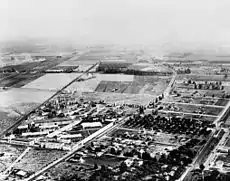
Hundreds of movies have been produced on the lots of Culver City's studios: Sony Pictures Studios (originally MGM Studios), Culver Studios, and the former Hal Roach Studios. These include The Wizard of Oz, The Thin Man, Gone with the Wind, Rebecca, the Tarzan series, and the original King Kong. More recent films made in Culver City include Grease, Raging Bull, E.T. the Extra-Terrestrial, The Man with Two Brains, City Slickers, Air Force One, Wag the Dog and Contact. Television series made on Culver City sets have included Las Vegas, Gunsmoke, Cougar Town, Mad About You, Lassie, Hogan's Heroes, Batman, The Green Hornet, Arrested Development, The Andy Griffith Show, Gomer Pyle, U.S.M.C., Jeopardy!, The Nanny, Hell's Kitchen, MasterChef, the syndicated version of Wheel of Fortune and Tosh. O. The television series The Green Hornet featured Bruce Lee as Kato; he resided in Culver City during its production.
John Travolta's "Stranded at the Drive-In" sequence in Grease was filmed at the Studio Drive-In on the corner of Jefferson and Sepulveda. It served as a set for many other films, including Pee-wee's Big Adventure. The theatre was closed in 1993 and demolished in 1998; it is now a housing subdivision featuring large homes on small lots, as well as the Kayne-ERAS center, a school and community center for the disabled and mentally challenged.
The historic Hull Building, 9543 Culver Boulevard at the northwest corner of Washington Boulevard and Watseka Avenue featured as Flynn's Arcade in the 1982 movie, Tron.
Culver City's streets have been featured in many films and television series. Since much of the architecture has not changed in decades, particularly in residential areas, the nostalgic sitcom The Wonder Years set many of its outdoor scenes in Culver City. The 1970s–80s series CHiPs also featured many chase scenes through the streets. The Nicolas Cage film Matchstick Men included scenes made at Veterans Memorial Park, which was also featured in the opening scenes of the sitcom The Hogan Family.
The Aviator, a film about Howard Hughes, featured several mentions of Culver City in connection with Hughes. Scenes from Bewitched (2005) with Nicole Kidman and Will Ferrell were also filmed in the Culver City streets. The film Fun with Dick and Jane (2005) starring Jim Carrey was filmed there. The closing aerial sequence of Get Shorty (1995) starring John Travolta and Danny DeVito is also filmed in Culver City, at Sony Pictures Studios. Additionally, scenes of Superbad (2007) starring Jonah Hill and Michael Cera were filmed in areas surrounding Culver City High School.
In 2010, the films Killers and Dinner for Schmucks were filmed in Culver City. In 2011, Lincoln Lawyer, Moneyball, Horrible Bosses and Jack and Jill were released, all of which were filmed in Culver City. Think Like a Man and The Campaign were filmed in Culver City and released in 2012.
Transportation
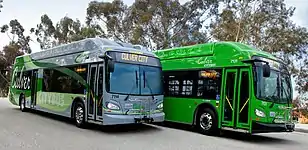
The Culver City station of the Los Angeles Metro E Line sits at the Culver Junction near Venice and Robertson Boulevards in Culver City. The E Line provides a light rail connection from Culver City to Downtown Los Angeles in the east and Downtown Santa Monica in the west, mostly following the right-of-way that the Pacific Electric Santa Monica Air Line used, also known as the Exposition Blvd line by PE. Culver City Station was the western terminus of what was then known as the Expo Line from its opening on June 20, 2012, to the opening of Expo Line phase two on May 20, 2016.[35]
Culver CityBus operates bus service within Culver City.[36]
The city is served by the Los Angeles International Airport, about 7 miles (11 km) south of the city.
Points of interest

.jpg.webp)
Businesses
- Culver Hotel:[37] A 1924 landmark pie-slice-shaped hotel downtown. Many of the cast of The Wizard of Oz stayed here during filming of the movie in 1939. The hijinks of that period, including the hotel's being taken over by the "Munchkins," were featured in the 1981 movie Under the Rainbow. Formerly owned by John Wayne, the hotel has housed many stars including Clark Gable, Greta Garbo, Joan Crawford, Red Skelton, Buster Keaton and Ronald Reagan.
- Helms Bakery[38]
- Westfield Culver City (formerly Fox Hills Mall) is a shopping mall owned by the Unibail-Rodamco-Westfield. Its anchor stores are Best Buy, JCPenney, Macy's, and Target.
- Beats Electronics
- Beats Music
- Big Frame and its subsidiaries Wonderly and Forefront.TV
- Maker Studios
- MedMen
- NPR West[39]
- Nuclear Blast
- Sony Pictures Studios
- The Ripped Bodice, the only romance novel bookstore in the northern hemisphere[40]
Education and research
- Antioch University Los Angeles is a small nonprofit liberal arts college in Culver City's Corporate Pointe district.
- West Los Angeles College[41] is a two-year community college in unincorporated Los Angeles County, adjacent to Culver City.
- UCLA IDEAS campus is a Suprastudio specialising in Architecture pertaining to entertainment, Mobility, Urban design and Technology.[42]
Museums and the arts
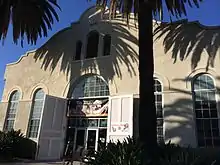
- The Actors' Gang[43] at the Ivy Substation (within the Palms district, city of Los Angeles, but on long-term lease to Culver City)
- Kirk Douglas Theatre,[44] featuring the Center Theater Group
- The Wende Museum[45] possesses a collection of Soviet and East German visual art and everyday artifacts to promote an understanding of Soviet art, history and culture between 1945 and 1991 and draw comparisons to contemporary events and issues.
Recreation
- Six mile Ballona Creek bicycle path
- Culver Boulevard Median bicycle path, a greenway featuring a two-mile bicycle and pedestrian trailways.
Parks
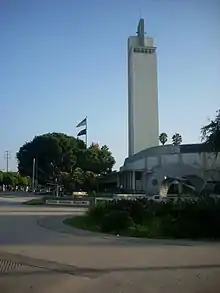
- Baldwin Hills Scenic Overlook
- Blair Hills Park
- Blanco Park
- Carlson Park
- Coombs Park
- Culver City Park
- The Boneyard (Dog Park)
- Culver City Skate Park
- Culver West Alexander Park
- El Marino Park
- Fox Hills Park
- Lindberg Park
- Syd Kronenthal Park
- Tellefson Park
- Veterans Park
Library
The County of Los Angeles Public Library operates the Julian Dixon Culver City Branch on Overland Ave.
Neighborhoods

Neighborhoods[46]
- Blair Hills
- Blanco
- Clarkdale
- Culver Crest
- Culver West
- Downtown Culver City
- Fox Hills
- Higuera
- Jefferson
- Lucerne
- McLaughlin
- McManus (East Culver City)
- Park East
- Park West
- Studio Village (Lindberg Park)
- Sunkist Park (El Marino)
- Veterans Park
Economy
Corporations with headquarters in Culver City include Beats Audio, MedMen, National Public Radio West, the NFL Network, NantHealth, Talespin Reality Labs,[47] Sweetgreen and Sony Pictures Entertainment.
Largest employers
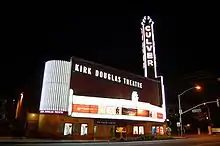
According to the city's 2015–16 Comprehensive Annual Financial Report,[48] the top employers in the city were:
| # | Employer | # of Employees |
|---|---|---|
| 1 | Sony Pictures Entertainment | 3,400 |
| 2 | Southern California Hospital at Culver City formerly Brotman Medical Center | 1,167 |
| 3 | City of Culver City | 871 |
| 4 | Culver City Unified School District | 760 |
| 5 | Goldrich & Kest Industries, LLC | 717 |
| 6 | Symantec | 700 |
| 7 | West Los Angeles College | 600 |
| 8 | Target | 575 |
| 9 | NFL Media | 525 |
| 10 | Apple, Inc. | 460 |
Geography
The city is surrounded by the Los Angeles neighborhoods of Mar Vista and Palms to the north; Westchester to the south; Mid-City, West Adams, and Baldwin Hills to the east; the Ladera Heights unincorporated area to the southeast; and the L.A. neighborhoods of Venice and Playa Vista to the west, along with the unincorporated area of Marina Del Rey.
The two primary ZIP codes for Culver City are 90230 and 90232. Because ZIP codes do not necessarily follow city boundaries, a portion of Culver City is in the 90066 ZIP code, which also serves some of the Mar Vista neighborhood of the city of Los Angeles.
Culver City's major geographic feature is Ballona Creek, which runs northeast to southwest through most of the city before it drains into Santa Monica Bay in Marina Del Rey.
Culver City is served by the San Diego, Santa Monica, and Marina freeways.
Culver City is at 34°0′28″N 118°24′3″W (34.007761, -118.400905).[49] According to the United States Census Bureau, the city has a total area of 5.1 square miles (13.2 km2), over 99% of which is land.
Culver City has a Mediterranean climate, typical of coastal California.
Climate
| Climate data for Culver City, California | |||||||||||||
|---|---|---|---|---|---|---|---|---|---|---|---|---|---|
| Month | Jan | Feb | Mar | Apr | May | Jun | Jul | Aug | Sep | Oct | Nov | Dec | Year |
| Record high °F (°C) | 91 (33) |
92 (33) |
95 (35) |
95 (35) |
91 (33) |
94 (34) |
98 (37) |
98 (37) |
106 (41) |
101 (38) |
101 (38) |
94 (34) |
106 (41) |
| Average high °F (°C) | 65.2 (18.4) |
66.4 (19.1) |
68.1 (20.1) |
70.4 (21.3) |
72.3 (22.4) |
75.4 (24.1) |
78.2 (25.7) |
79.3 (26.3) |
78.2 (25.7) |
73.9 (23.3) |
69.3 (20.7) |
64.9 (18.3) |
71.8 (22.1) |
| Daily mean °F (°C) | 56.5 (13.6) |
57.8 (14.3) |
59.3 (15.2) |
61.7 (16.5) |
64.9 (18.3) |
67.7 (19.8) |
70.5 (21.4) |
71.3 (21.8) |
70.2 (21.2) |
65.4 (18.6) |
60.4 (15.8) |
56.1 (13.4) |
63.5 (17.5) |
| Average low °F (°C) | 48.3 (9.1) |
49.2 (9.6) |
50.4 (10.2) |
52.9 (11.6) |
57.4 (14.1) |
59.9 (15.5) |
62.8 (17.1) |
63.2 (17.3) |
62.1 (16.7) |
56.9 (13.8) |
51.4 (10.8) |
47.3 (8.5) |
55.2 (12.9) |
| Record low °F (°C) | 27 (−3) |
34 (1) |
35 (2) |
42 (6) |
45 (7) |
48 (9) |
52 (11) |
51 (11) |
47 (8) |
48 (9) |
38 (3) |
32 (0) |
27 (−3) |
| Average rainfall inches (mm) | 3.19 (81) |
3.25 (83) |
2.66 (68) |
0.58 (15) |
0.26 (6.6) |
0.04 (1.0) |
0.02 (0.51) |
0.07 (1.8) |
0.08 (2.0) |
0.33 (8.4) |
0.94 (24) |
1.90 (48) |
13.32 (338) |
| Average rainy days (≥ 0.01 inch) | 5.7 | 5.3 | 5.8 | 1.7 | 0.7 | 0.2 | 0.3 | 0.2 | 0.6 | 1.1 | 1.9 | 4.0 | 27.5 |
| Source 1: NOAA[50] | |||||||||||||
| Source 2: The Weather Channel[51] | |||||||||||||
Education
Primary and secondary schools
Culver City has its own school district, Culver City Unified School District. It has five elementary schools, a middle school, two high schools (regular and continuation), a Community Day School, an Office of Child Development, and an Adult School. There are three elementary schools that are part of the Los Angeles Unified School District. In addition, there is an Independent Study program where students of elementary, middle school, or high school age can make a weekly appointment to drop off and pick up homework, which is to be completed throughout the week.
STAR Prep Academy, a private middle and high school, was established in 2004 and shares its campus with the STAR ECO Station, an exotic wildlife rescue center. It is one of the few schools in the United States where students can work with exotic and endangered animals daily as part of their curriculum.[52]
The Willows Community School is a private primary, elementary and middle school, grades DK through 8, established in 1994 on Higuera Street.
Turning Point School is an independent primary, elementary and middle school, serving students from 2 years 9 months through grade 8, on National Blvd.
Kayne Eras Center is on Machado Road. In July 2008, the Kayne Eras Center merged with the Exceptional Children's Foundation, creating the only agency in Southern California that provides a continuum of services to individuals with disabilities from birth through adulthood..
Wildwood School is a private primary, elementary, middle and high school, grades K through 12, established in 1971 on McManus Avenue.
Echo Horizon School is a private primary, elementary, and middle school, grades Pre-K through 6, established in 1985 on McManus Avenue.
Culver City High School's Academy of Visual and Performing Arts (AVPA) is a "specialized secondary program" created in 1996 through a grant from the state of California with major support from Sony Pictures Entertainment. The program offers classes in departments of Music, Theatre, Visual Art, Film, and Dance that occur after the regular school day at Culver City HS has ended.
Colleges and universities
West Los Angeles College, in an unincorporated section of Los Angeles County adjacent to Culver City,[53] is part of the Los Angeles Community College District. Antioch University Los Angeles is on Corporate Point, off Slauson Avenue.
Other
The Los Angeles County Probation Department's Training Academy is on the campus of West L.A. College.
Culver City has the Los Angeles area campus of the Gemological Institute of America as well as the Academy of Beauty and the Biofeedback Institute of Los Angeles.
Demographics
2010
The 2010 United States Census[54] reported that Culver City had a population of 38,883. The population density was 7,566.0 people per square mile (2,921.2/km2). The racial makeup of Culver City was 23,450 (60.3%) White,[55] 3,694 (9.5%) African American, 191 (0.5%) Native American, 5,742 (14.8%) Asian, 81 (0.2%) Pacific Islander, 3,364 (8.7%) from other races, and 2,361 (6.1%) from two or more races. Hispanic or Latino of any race were 9,025 persons (23.2%).
The Census reported that 38,572 people (99.2% of the population) lived in households, 84 (0.2%) lived in non-institutionalized group quarters, and 227 (0.6%) were institutionalized.
There were 16,779 households, out of which 4,499 (26.8%) had children under the age of 18 living in them, 6,826 (40.7%) were opposite-sex married couples living together, 1,882 (11.2%) had a female householder with no husband present, 636 (3.8%) had a male householder with no wife present. There were 922 (5.5%) unmarried opposite-sex partnerships, and 157 (0.9%) same-sex married couples or partnerships. 5,649 households (33.7%) were made up of individuals, and 1,956 (11.7%) had someone living alone who was 65 years of age or older. The average household size was 2.30. There were 9,344 families (55.7% of all households); the average family size was 3.01.
The population was spread out, with 7,312 people (18.8%) under the age of 18, 2,711 people (7.0%) aged 18 to 24, 12,098 people (31.1%) aged 25 to 44, 10,956 people (28.2%) aged 45 to 64, and 5,806 people (14.9%) who were 65 years of age or older. The median age was 40.5 years. For every 100 females, there were 89.1 males. For every 100 females age 18 and over, there were 85.6 males.
There were 17,491 housing units at an average density of 3,403.5 per square mile (1,314.1/km2), of which 9,111 (54.3%) were owner-occupied, and 7,668 (45.7%) were occupied by renters. The homeowner vacancy rate was 0.7%; the rental vacancy rate was 4.1%. 21,549 people (55.4% of the population) lived in owner-occupied housing units and 17,023 people (43.8%) lived in rental housing units.
According to the 2010 United States Census, Culver City had a median household income of $77,333, with 7.1% of the population living below the federal poverty line.[55]
2000
As of the census[56] of 2000, there were 38,816 people, 16,611 households, and 9,518 families residing in the city. The population density was 7,589.8 inhabitants per square mile (2,932.9/km2). There were 17,130 housing units at an average density of 1,294.3/km2 (3,349.5/mi2). The racial makeup of the city was 59.24% White, 11.96% Black or African American, 0.71% Native American, 12.02% Asian, 0.21% Pacific Islander, 10.16% from other races, and 5.69% from two or more races. 23.70% of the population were Hispanic or Latino of any race.
There were 16,611 households, out of which 26.1% had children under the age of 18 living with them, 40.8% were married couples living together, 12.8% had a female householder with no husband present, and 42.7% were non-families. 34.5% of all households were made up of individuals, and 9.3% had someone living alone who was 65 years of age or older. The average household size was 2.31 and the average family size was 3.02.
In the city, the population was spread out, with 20.9% under the age of 18, 6.6% from 18 to 24, 33.3% from 25 to 44, 25.3% from 45 to 64, and 13.9% who were 65 years of age or older. The median age was 39 years. For every 100 females, there were 87.5 males. For every 100 females age 18 and over, there were 82.7 males.
The median income for a household in the city was $51,792, and the median income for a family was $61,451, these figures had risen to $65,525 and $82,582 as of a 2007 estimate.[57] Males had a median income of $46,683 versus $41,478 for females. The per capita income for the city was $29,025. About 5.5% of families and 8.6% of the population were below the poverty line, including 12.1% of those under age 18 and 5.1% of those age 65 or over.
Government
In Los Angeles County, Culver City is in the 2nd Supervisorial District, represented by Mark Ridley-Thomas.
In the California State Legislature, Culver City is in the 30th Senate District, seat currently vacant, and in the 54th Assembly District, represented by Democrat Sydney Kamlager.[58]
In the United States House of Representatives, Culver City is in California's 37th congressional district, represented by Democrat Karen Bass.[59]
Public services
The Los Angeles County Department of Health Services SPA 5 West Area Health Office serves Culver City.[60] The department operates the Simms/Mann Health and Wellness Center in Santa Monica, serving Culver City.[61]
The United States Postal Service operates the Culver City Post Office at 11111 Jefferson Boulevard and the Gateway Post Office at 9942 Culver Boulevard.[62][63]
Culver City is served by its own police force, the Culver City Police Department, at 4040 Duquesne Avenue.[64]
Culver City's fire department (ISO class 1), the Culver City Fire Department, has its headquarters at 9600 Culver Boulevard.[65]
Culver CityBus was founded on 4 March 1928, making it the second oldest municipal bus line in California[66] and the oldest public transit bus system still operating in Los Angeles County.[67] Big Blue Bus was founded on 14 April 1928.[67][68]
Sister cities
Culver City has five sister cities, as designated by Sister Cities International:
Notable people
See alsoReferences
External links
|
